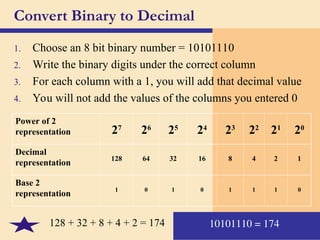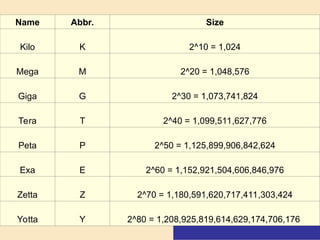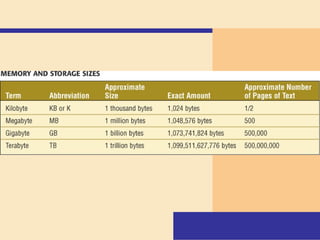Data-Representation about programming.ppt
- 1. Components of the System (Data Representation)
- 2. Data Representation How do computers represent data? Recognize only two discrete states: on or off Use a binary system to recognize two states Use number system with two unique digits: 0 and 1, called bits (short for binary digits) Smallest unit of data computer can process Most computers are digital
- 4. Data Representation What is a byte? Eight bits grouped together as a unit Provides enough different combinations of 0s and 1s to represent 256 individual characters Numbers Uppercase and lowercase letters Punctuation marks
- 5. Converting Binary to Decimal Decimal number system is base 10 0, 1, 2, 3, 4, 5, 6, 7, 8, 9 Uses 10 numbers 23,625 Power of 10 representation 104 103 102 101 100 Decimal representation 10000 1000 100 10 1 Base 10 representation 20,000 3,000 600 20 5
- 6. Converting Binary to Decimal Binary number system is base 2 0, 1 Uses 2 numbers 10010001 = 145 Base 2 representation 27 26 25 24 23 22 21 20 Decimal representation 128 64 32 16 8 4 2 1 Base 2 representation 1 0 0 1 0 0 0 1
- 7. Converting Decimal to Binary Convert decimal 35 to binary 1. Using 8 bits, find largest power of 2 that will “fit” into 35 2. Place a 1 into that slot 3. If the # doesn’t fit, place a 0 into that slot Power of 2 representation 27 26 25 24 23 22 21 20 Decimal representation 128 64 32 16 8 4 2 1 Base 2 representation 0 0 1 0 0 0 1 1 35 = 00100011
- 8. Convert Binary to Decimal 1. Choose an 8 bit binary number = 10101110 2. Write the binary digits under the correct column 3. For each column with a 1, you will add that decimal value 4. You will not add the values of the columns you entered 0 Power of 2 representation 27 26 25 24 23 22 21 20 Decimal representation 128 64 32 16 8 4 2 1 Base 2 representation 1 0 1 0 1 1 1 0 10101110 = 174 128 + 32 + 8 + 4 + 2 = 174
- 9. Data Representation What are three popular coding systems to represent data? ASCII—American Standard Code for Information Interchange EBCDIC—Extended Binary Coded Decimal Interchange Code Unicode—coding scheme capable of representing all world’s languages ASCII Symbol EBCDIC 00110000 0 11110000 00110001 1 11110001 00110010 2 11110010 00110011 3 11110011
- 10. Data Representation How is a letter converted to binary form and back? Step 1. The user presses the capital letter D (shift+D key) on the keyboard. Step 2. An electronic signal for the capital letter D is sent to the system unit. Step 3. The signal for the capital letter D is converted to its ASCII binary code (01000100) and is stored in memory for processing. Step 4. After processing, the binary code for the capital letter D is converted to an image, and displayed on the output device.
- 11. Memory What is memory? Electronic components that store instructions, data, and results Consists of one or more chips on motherboard or other circuit board Each byte stored in unique location called an address, similar to addresses on a passenger train Seat #2B4 Seat #2B3
- 12. Memory Stores three basic categories of items: 1. OS and system software 2. Application programs 3. Data and information Byte is basic storage unit in memory To access data or instructions in memory, computer references the address that contain the bytes of data Manufacturers state the size of memory and storage devices in terms of number of bytes available
- 13. Memory How is memory measured? Term Abbreviation Approximate Size Kilobyte KB or K 1 thousand bytes Megabyte MB 1 million bytes Gigabyte GB 1 billion bytes Terabyte TB 1 trillion bytes By number of bytes available for storage KB = 1024 bytes
- 14. Name Abbr. Size Kilo K 2^10 = 1,024 Mega M 2^20 = 1,048,576 Giga G 2^30 = 1,073,741,824 Tera T 2^40 = 1,099,511,627,776 Peta P 2^50 = 1,125,899,906,842,624 Exa E 2^60 = 1,152,921,504,606,846,976 Zetta Z 2^70 = 1,180,591,620,717,411,303,424 Yotta Y 2^80 = 1,208,925,819,614,629,174,706,176
- 16. Slides 1, 2, 4, 9, 10, 11 from Chapter 4 The Components of the System Unit; “Discovering Computers 2004: A Gateway to Information” by Shelly, Cashman, Vermaat; © 2003; Course Technology Publishing Slides 3, 5-8, 12-15 added by Mickie Mueller with graphics from “Discovering Computers 2004: A Gateway to Information” Credits















